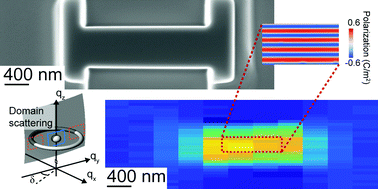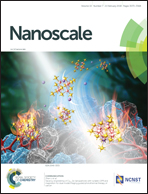Domain alignment within ferroelectric/dielectric PbTiO3/SrTiO3 superlattice nanostructures†
Abstract
The ferroelectric domain pattern within lithographically defined PbTiO3/SrTiO3 ferroelectric/dielectric heteroepitaxial superlattice nanostructures is strongly influenced by the edges of the structures. Synchrotron X-ray nanobeam diffraction reveals that the spontaneously formed 180° ferroelectric stripe domains exhibited by such superlattices adopt a configuration in rectangular nanostructures in which domain walls are aligned with long patterned edges. The angular distribution of X-ray diffuse scattering intensity from nanodomains indicates that domains are aligned within an angular range of approximately 20° with respect to the edges. Computational studies based on a time-dependent Landau–Ginzburg–Devonshire model show that the preferred direction of the alignment results from lowering of the bulk and electrostrictive contributions to the free energy of the system due to the release of the lateral mechanical constraint. This unexpected alignment appears to be intrinsic and not a result of distortions or defects caused by the patterning process. Our work demonstrates how nanostructuring and patterning of heteroepitaxial superlattices allow for pathways to create and control ferroelectric structures that may appear counterintuitive.



 Please wait while we load your content...
Please wait while we load your content...